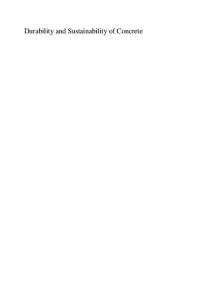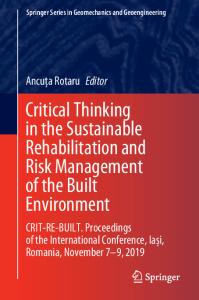Ageing and durability of concrete structures
The serviceability of concrete structures is a coupled problem in which fracture and damage are coupled with several environmental attacks. In this chapter, we start with the investigation of chemo-mechanical damage due to calcium leaching. We show that t
- PDF / 3,290,308 Bytes
- 32 Pages / 481.89 x 691.654 pts Page_size
- 74 Downloads / 317 Views
Abstract: The serviceability of concrete structures is a coupled problem in which fracture and damage are coupled with several environmental attacks. In this chapter, we start with the investigation of chemo-mechanical damage due to calcium leaching. We show that the fracture characteristics, namely the internal length in continuum models evolve with ageing. This observation is confirmed with experiments on model materials. Acoustic emission data and size effect tests data are strongly correlated with the evolution of the microstructure of the material. This chapter concludes on some creep tests designed to investigate the coupled effect between creep and fracture.
9.1.
Introduction
The serviceability concrete structures used for instance in waste containment or electric production facilities is a coupled problem. These concrete structures are subjected to various mechanical loads, soil structure interactions, and at the same time to chemical aggressions. In order to determine the service life of such structures, prediction of the material response and structural failure with time are required. Typically, this kind of problem involves two sources of damage: one due to mechanical loads, and another one due to environmental actions. In the following, we are going to give examples of such coupled mechanisms. The first one deals with leaching of concrete. It is related to the safety of nuclear waste disposal systems. Then, we will discuss results obtained with model materials aimed at describing this type of chemical damage and we will be interested with the variation of the internal length in the course of the ageing process. Finally, recent experiments on creep- fracture interaction will be presented. These tests aim at evaluating the capacity of prestressed concrete structures and its variation during ageing.
9.2.
Leaching of cementitious materials
The long-term behaviour of concrete structures subjected to environmental damage is a topic of the utmost importance for waste containment disposals. In the case of long-life wastes (such as radioactive wastes), the models cannot rely on experimental data over the entire service life of the disposal, which spans over several hundred years. Assessing such structures and comparing several possible designs prior to their construction must rely on robust and accurate computational tools, in which the knowledge of the various degradation mechanisms at the material level must be incorporated. Here, the mechanism of degradation considered is F. Darve et al. (eds.), Degradations and Instabilities in Geomaterials © Springer-Verlag Wien 2004
G. Pijaudier-Cabot, K. Haidar et al.
256
leaching due to water, and particularly calcium leaching as calcium is the most important element in the hydrated cement paste. The consequences of calcium leaching are an increase of porosity, a decrease of the elastic stiffness and a decrease of strength (Carde 1996, Gerard 1996, Carde and Francois 1997). It is this decrease of the mechanical properties that is addressed more specifically. Th
Data Loading...











